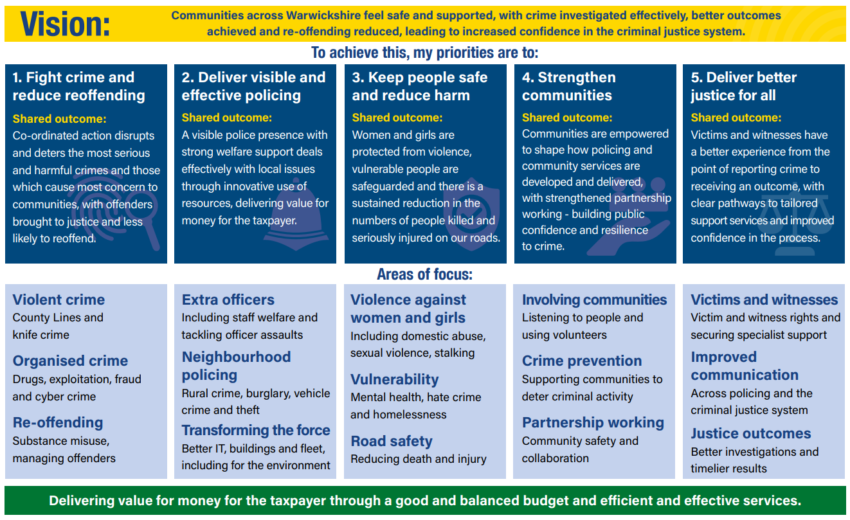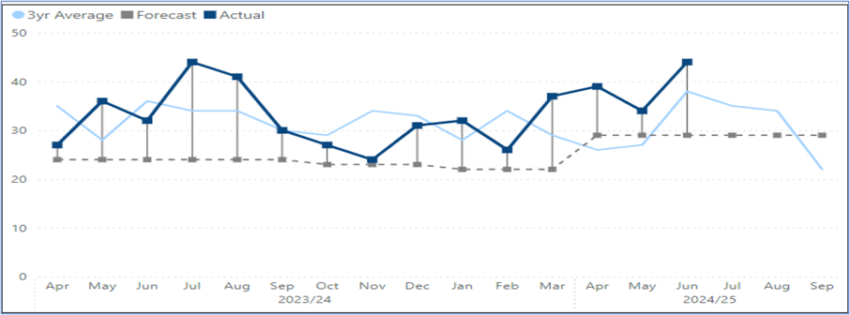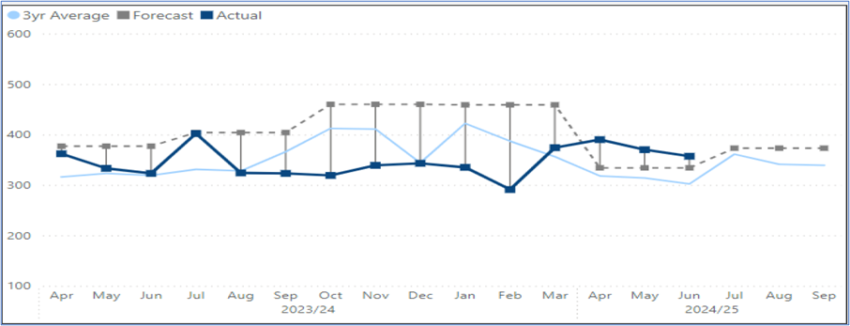1. Introduction
The previous Government’s National Crime and Policing Measures (NCPM) are intended to compliment the local priorities that are set out in Police and Crime Commissioners’ (PCC) Police and Crime Plans; nonetheless the Government was clear that forces must achieve significant reductions in crime and restore the public’s confidence in the criminal justice system. The six key priorities of the NCPM are: –
- Reduce murder and other homicides.
- Reduce serious violence.
- Disrupt drugs supply and county lines.
- Reduce neighbourhood crime.
- Tackle cyber-crime.
- Improve satisfaction among victims – with a particular focus on victims of domestic abuse.
2. Specified Information Order
In August 2021, the ‘Elected Local Policing Bodies (Specified Information) (Amendment) Order 2021’ came into effect, requiring PCCs to publish information relating to a police force’s performance against the NCPM and thereby enabling greater public scrutiny of police performance and to allow the electorate to hold PCCs to account more effectively. The order states that: –
- PCCs are required to provide a statement on the contribution of their force to achieving improvements against those priorities.
- The information must be published in a prominent place on the PCC’s website. The purpose of this requirement is to make it as easy as possible for the public to access the information, and quarterly updates should be made following the publication of quarterly crime statistics.
3. Statement of Contribution
On 31 March 2022, the Warwickshire Police and Crime Commissioner (PCC) formally published the ‘Police and Crime Plan 2021-2025’. The objectives set within the plan have been formulated with consideration of the requirements of the NCPM.

Figure 1 – The Police and Crime Plan on a Page
The PCC wants to ensure that all agencies are working together to reduce crime, support victims and make communities safer, to ensure delivery against the NCPM priorities. This collaboration is achieved through regular engagement with local communities, the police, partners, and community safety organisations. The PCC’s position as the Chair of the Local Criminal Justice Board also enables him to monitor the provision of an effective and efficient criminal justice system in Warwickshire.
In terms of the PCC responsibilities to ‘hold to account’ the Chief Constable for the performance of Warwickshire Police, the PCC holds a formal monthly ‘Governance and Scrutiny Board’ (GSB) meeting with the Chief Constable. The purpose of the GSB is to focus on specific areas of force performance and is attended by senior officers and staff from the force and the Office of the Police and Crime Commissioner (OPCC). The minutes of the meetings are published on the OPCC website. At each GSB a topical ‘Focus subject’ of particular interest is selected for in-depth scrutiny and discussion.
4. Warwickshire Police Overview
The Govt. baseline for NCPM is the performance data for the calendar year 2019 and there are specific measures for the six priority areas. The Home Office recognise that not all measures will apply equally to every force, so PCCs must consider how best to apply these measures in their force area. Warwickshire Police has therefore selected some additional proxy measures to assess the force’s contribution towards these national priorities and the force will continue to develop its approach to ensure that the measures are aligned with the national position.
This report has principally been prepared through scrutiny of the performance data provided in Warwickshire Police’s monthly performance reports for Q3 2023/24: –
- Performance Monthly Insights – June 2024.
- Performance Monthly Insights – May 2024.
- Performance Monthly Insights – April 2024.
A summary of the force’s and OPCC position, with commentary, is provided as follows.
5. Reduce Murder and Other Homicides
5.1. Force data
- In 2023/24, there were six homicides recorded, an increase on the five recorded in the previous year.
- In Q1 2024/25, there were two homicides recorded. These rates of recorded homicide are comparable to the national average.
- The Home Office identify an ‘outlier’ as an increase equal or greater than five homicides (negative outlier), or a decrease equal or greater than five homicides (positive outlier), between the latest six-month period and the equivalent six-month period in the previous year.
- Warwickshire Police is not an ‘outlier’.
5.2. OPCC Commentary
Murder and homicides are allied to the subject of Serious Violence and are therefore discussed in the following section.
6. Reduce Serious Violence
The Govt. measures are: –
- Offences involving the discharge of a firearm
- The force’s proxy Hospital admissions for persons under 25 years old injured with sharp instrument (NHS measure).
The force’s measures are: –
- Serious violence (Violence with Injury, and Robbery).
- Offences involving knife crime or sharp instruments.
- Offences involving the use of a firearms.
6.1. Force data
a) Serious Violence – Seasonal
Violence with Injury
- The Home Office baseline is the data for 2019 data (n=4,649).
- In 2023/24, volumes (n=4,855) increased by +3% on the previous year.
- In Q1 2024/25, volumes (n=1,262) increased by +15% (n=1,094) when compared to the previous Q4 2023/24.
- Levels are seasonably variable and were consistent with both the 3-year average and forecast.
- In June 2024, the 3-month rolling average ‘action taken’ outcome rate was at 16.8%.
Robbery Personal
- The Home Office baseline is the data for 2019 (n=398).
- In 2023/24, volumes (n=347) increased by +5% on the previous year.
- In Q1 2024/25, volumes (n=117) increased by 23% (n=95) when compared to the previous Q4 2023/24.
- Levels were above the 3-year average and forecast: –

Figure 2: Robbery Volumes
b) Knife Crime
The Home Office data collection for offences involving knives or sharp instruments is limited to selected offences and certain weapon types. It excludes possession offences. Knife crime is not a designated Home Office crime category.
- In June 2024, volumes (n=27) were below the 3-year average.
- The force’s Annual Data Return showed a -20% reduction in knife crime when compared to the previous year – a positive position!
c) Firearms
- The Home Office baseline is the 2019 data (n=57). The Home Office data collection reports on offences where a firearm was used as a ‘threat’.
- In 2023/24, volumes (n=64) increased by +20% on the previous year.
- In Q1 2024/25, there were 20 firearms offences recorded.
- The June 2024 volumes significantly decreased on the previous four-month volumes and was below the 3-year average.
6.2 OPCC Commentary
A question is to be raised at the ‘holding to account’ Q1 2024/25 Governance and Scrutiny Board (GSB), regarding the specific measures the force are taking to improve the ‘action taken’ outcome rates for robbery.
The OPCC continued to provide support and oversight of the application of the Serious Violence Duty (SVD) in the county, including attendance at the Serious Violence Prevention Partnership in April 2024, and finalisation of the required submissions to the Home Office for 2023-24 in relation to the SVD grant. The OPCC is now working closely with the Specified Authorities to finalise plans for further interventions to reduce serious violence that will take place during 2024-25.
Multi-Agency Public Protection Arrangements (MAPPA) oversee and manage some of the most serious offenders in the county, including violence and sexual offenders. Oversight and governance of the arrangements are delivered through a MAPPA Strategic Management Board (SMB). From April 2024, the OPCC has begun attending the SMB to give the PCC greater insight and assurance of MAPPA and to identity any further ways that the OPCC can support the responsible authorities to reduce the most serious reoffending.
7. Disrupt Drugs and County Lines
The Govt. measures are: –
- a) Drug Related Homicide.
- b) Police Referred Drug Treatment (supplied by Public Health England).
The force’s proxy measures are: –
- a) Drug related homicides.
- b) Organised Crime Group (OCG) disruption.
7.1. Force data
a) Drug Related Homicide
The force does not disaggregate this information within the performance framework, due to the low volume of homicide within the county. External data indicates that since 2016 around 44% of the force’s homicides carried a ‘drug’ marker, below the national rate. In 2023, Warwickshire Police completed a ‘Homicide and Near Miss Problem Profile’ that indicated that the drug market influenced 8% of such incidents.
b) Organised Crime Groups (OCG)
In June 2024, there were 97 approved disruptions of OCGs in the county. Of note is that 4 adults and 14 children were safeguarded during this period. Given the complexity and sensitivity of OCGs and County-lines activity, which predominately involve cross-border crime, qualitative comment cannot be provided without further context; it has however been noted that there has been a significant increase in OCG disruption during the last 12-months.
7.2. OPCC Commentary
A question is to be raised at the ‘holding to account’ Q1 2024/25 GSB, regarding the causes for the significant increase in OCG disruptions during the last 12-months.
The OPCC continues to provide support and oversight to the introduction of ‘Project Stronghold’ in Warwickshire, which is the county’s partnership response to the rollout of the national ‘Clear, Hold, Build’ methodology, designed to make an area a safer place to live and work. This response aims to tackle organised crime groups acting in the neighbourhood, build community resilience, and improve confidence and trust in the police. My office also continues to influence the development of a coordinated countywide partnership strategy for SOC.
8. Reduce Neighbourhood Crimes
The Govt. measures are: –
- Burglary.
- Theft from, and of, vehicle (Crime Survey England & Wales – CSEW).
- Theft from Person.
The force’s measures are: –
- & b) & c) Home Office Crime Recording categories
8.1. Force data
a) Burglary (Home) – Seasonal
- The Home Office baseline is the data for 2019 (n=2,694).
- In 2023/24, volumes (n=1,107) decreased by -2% on the previous year.
- In Q1 2024/25, volumes (n=267) decreased by -7% (n=287) when compared to the previous Q4 2023/24.
- Levels were consistent with the 3-year average and forecast.
- Of note is that in June 2024, 100% of reports were attended by police.
- Of note is that the action taken outcome rate for March and April 2024 demonstrates a significant improvement: –
b) Vehicle Crime
- The Home Office baseline is the data for 2019 (n=4,614).
- In 2023/24, volumes (n=4,090) decreased by -13% on the previous
- In Q1 2024/25, volumes (n=1,117) increased by +7% (n=1,000) when compared to the previous Q4 2023/24.
- Of concern, is the consistently low levels of action taken outcomes for Vehicle Crime.
- Volumes remained above the 3-year average and forecast: –

Figure 3: Vehicle Crime Volumes
c) Theft from Person
- The Home Office baseline is the data for 2019 (n=394).
- In 2023/24, volumes (n=258) were consistent with the previous year.
- In Q1 2024/25, volumes (n=51) increased by +64% (n=132) when compared to the previous Q4 2023/24.
- Despite this increase, levels remained consistent with the 3-year average and below the forecast.
- The ‘action taken’ outcome rates remain mercurial given the low number of offences recorded.
8.2. OPCC Commentary
A question is to be raised at the ‘holding to account’ Q1 2024/25 GSB, regarding the specific measures the force are taking to improve the ‘action taken’ outcome rates for vehicle crime.
In December 2023, it was announced that the OPCC had been awarded £1m by the Home Office from the Anti-social Behaviour (ASB) ‘Hotspot Response Fund 2024/25’. The aim of this funding is to ensure there is an enhanced uniformed presence in ASB and serious violence ‘hotspot’ areas across the county. On 1 May 2024, Warwickshire Police commenced enhanced patrolling of the 18 areas identified.
In 2016 at the start of the PCC’s first term of office as Police and Crime Commissioner, Warwickshire Police had some 800 police officers in post. A key pledge of the Police and Crime Plan 2021-2025 was to continue have more police officers as part of the wider plans to deliver visible and effective policing. Thanks to a combination of increases in the local Council Tax Police Precept and funding from the Government’s Police Uplift Programme, I am extremely pleased to be able to confirm that the force now has a headcount of 1,140 officers in post.
9. Victim Satisfaction
The Govt. measures are: –
- Victim satisfaction with police by victims of domestic abuse.
- Victim satisfaction with police (CSEW) – Not available.
The force’s proxy measures are: –
- Force’s own domestic abuse victim satisfaction survey (not comparable with other forces).
- Victim satisfaction surveys.
9.1. Force data
Of note is that Warwickshire Police has now set ‘target rates’ for Victim Satisfaction. In June 2024, the ‘whole experience satisfaction’ trend delivered the following levels of performance: –
| Category | Target % | In Month
c% |
Rolling 6-month %
Q4 2023/24 |
Rolling 6-month %
Q1 2024/25 |
| Domestic Abuse | 80 | 84 | 75 | < 78 |
| Vehicle Crime | 70 | 73 | 64 | < 66 |
| Violence | 75 | 55 | 68 | > 66 |
| Burglary | 80 | 83 | 75 | > 80 |
| Hate Crime | 80 | 98 | 72 | < 67 |
Figure 4: Victim satisfaction rates.
There are some rolling six-month improvements (Domestic Abuse and Vehicle Crime, along with a notable improvement in the in-month rate for Hate Crime. However, except for Burglary, all other satisfaction rates are below the targets set.
A question was raised in the Q4 2023/24 OPCC Performance Scrutiny report regarding the action Warwickshire Police was taking regarding the low rates for the ‘whole experience satisfaction’ for Hate Crime, and the ‘follow up’ measure for Vehicle Crime. It is therefore positive to note the significant improvement achieved for Hate Crime, together with the improvement in the follow up metric for Vehicle Crime that rose form 40% in May 2024 to 56% in June 2024.
Victim Satisfaction will continue to remain under scrutiny by the OPCC given its significance to the objectives of the Police and Crime Plan 20221-2025.
9.1. OPCC Commentary
A question is to be raised at the ‘holding to account’ Q1 2024/25 GSB, regarding Warwickshire Police’s capacity, capability and resilience to effectively manage the high volumes of victims contact and victim support.
The OPCC works closely with Warwickshire County Council and other partners in delivering the aims of the county’s ‘Violence Against Women and Girls (VAWG) Strategy’. This has included reviewing the governance arrangements and working closely to link the work of the county’s VAWG Board with the work of the Local Criminal Justice Board (LCJB). This is particularly important in relation to progress to improve criminal justice outcomes for victims of Sexual Violence and Domestic Abuse.
The PCC commissions the following services for victims-survivors in Warwickshire: –
- General victim support: Victim Support
- Sexual violence and abuse: Safeline
- Child exploitation: Barnardo’s
- Restorative Justice: Victim Support
- Modern Slavery and Human Trafficking: West Midlands Anti-Slavery Network
10. Tackle Cyber Crime
The Govt. measures are: –
- Confidence in law enforcement response.
- Percentage of businesses experiencing cyber-crime. Data taken from non-police sources.
The force’s proxy measures are: –
- Action Fraud cyber-dependent victim referrals where advice given.
10.1. Force data
Cyber-crime data is not included in the Q1 2024/25 Performance Reports. Warwickshire Police’s position is that the force currently reports cyber-crime measures through the Proactive Preventative Steering Group (P&PSG). Cyber Crime reporting is transitioning to Agency and Partner Management Information System (APMIS), the national system for recording cyber-crime disruptions. This measure is available through the DCPP tool.
The DCPP states that: “Regional and organised crime units and the National Crime Agency record information about operational activity and outcomes in APMIS. They also record quantitative outcomes such as criminal justice and seizures. All agencies record disruptions, which are common measure of the impact of law enforcement actions on disrupting the operation of organised crime groups, vulnerabilities or individuals involved in serious crime. The force recording the crime may not be the only force associated in the action. While APMIS data in the DCPP is refreshed monthly, forces only update their counts on a quarterly basis.”
10.2. OPCC commentary
In April 2024, a report was prepared for the Police and Crime Panel Performance Working Group on the national, regional, and local response and capabilities in respect of cybercrime.
The Deputy PCC a board member on the Regional Cyber Resilience Forum and is working hard to ensure that Warwickshire is being supported by this regional resource to prevent cyber-attacks to businesses in the county.

